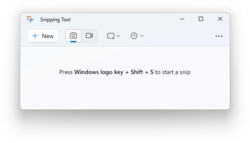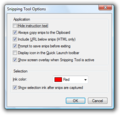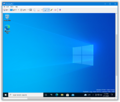Snipping Tool
| Component of Microsoft Windows | |
 Snipping Tool in Windows 11 2024 Update | |
| Introduced in | Windows XP Tablet PC Edition |
|---|---|
Snipping Tool is a screenshot utility included with Microsoft Windows. It was first introduced as an optional download for Windows XP Tablet PC Edition and then included in Windows Vista. Since Windows 10 October 2018 Update, it has been complemented by a similar tool called Snip & Sketch, which was later renamed to Snipping Tool as it replaced the original app in Windows 11.
History[edit | edit source]
Snipping Tool's first version was available as a downloadable PowerToy for Windows XP Tablet PC Edition, which was known as Snipping Tool for Tablet PC, and was released alongside Microsoft Tablet PC on 7 November 2002.[1] It was a basic screen snipping app that took advantage of the Tablet PC pen to "cut out" a specific area of the computer, and then make highlights, annotations, or marks using it.
Windows Vista and later[edit | edit source]
A new version of the tool was included starting with Windows Vista, introducing it to traditional PC users. It allows users to take a screenshot in one out of several modes and then quickly annotate it without using any other application. The tool would see no updates until Windows 10, which added a delay feature that allowed to take snips with a delay of between 1 and 5 seconds. In future updates, the user interface was further refined with updated icons and snipping modes being moved from the New split button to the new Mode menu.
Snip & Sketch[edit | edit source]
In build 14328, the Windows Ink Workspace was introduced. It includes Screen Sketch, which could take a full-screen capture of the screen and then make annotations. This was similar to the original version of the Snipping Tool for Tablet PCs.
Screen Sketch received a major overhaul in Windows 10 October 2018 Update. It was modified into a full app updated through the Microsoft Store in build 17661.1001, with a new redesigned user interface that made it similar to the Snipping Tool. It also introduced a new ⊞ Win+⇧ Shift+S key stroke, which would open a new full screen interface when pressed. The interface allows the user to pick a selection mode and select an area to be snipped. The new app can also optionally handle the PrtScn hotkey.
Screen Sketch was later renamed to Snip & Sketch in build 18219, and was then backported to Redstone 5 builds starting with build 17751.
Deprecation[edit | edit source]
In build 17661.1001, the original Snipping Tool was updated to include a note that the app would be removed from the operating system in a future update. After this, the deprecation process started, as new features related to the snipping experience were now added to the newer Snip & Sketch app instead of Snipping Tool.
Further steps were taken towards its removal during Windows 10 post-20H1 builds. Snipping Tool first became an optional feature in build 21277, letting users uninstall it and keep only Snip & Sketch. Starting with build 21354, it was moved to the Microsoft Store and included alongside Snip & Sketch in a single package called "Snip & Sketch and Snipping Tool".
Windows 11[edit | edit source]
Windows 11 build 22000.132 introduced a new version of Snip & Sketch, now renamed to Snipping Tool. The app has a new icon and was redesigned in order to look similar to the classic Snipping Tool, but also retains Snip & Sketch specific features such as the ⊞ Win+⇧ Shift+S key stroke and the improved annotation interface.
Version 11.2209.2.0 allows for snips to be automatically saved to the user's screenshots folder.
In Feedback Hub quests, a reference of the 11.2211.11.0 version of Snipping Tool showing how to use the screen recorder feature was added. The feature would later be introduced in version 11.2211.35.0, which was released to Windows Insiders on Dev Channel on 8 December 2022, and an updated version to the Beta Channel on 26 January 2023.
The combined capture bar is first introduced in version 11.2307.44.0.
Gallery[edit | edit source]
Windows XP Tablet PC Edition[edit | edit source]
Setup[edit | edit source]
General[edit | edit source]
Windows Vista[edit | edit source]
Windows 10[edit | edit source]
Windows 11[edit | edit source]
Windows 11 2024 Update[edit | edit source]
Miscellaneous[edit | edit source]
Icon used from Windows 10 Creators Update to Windows 10 2022 Update






























